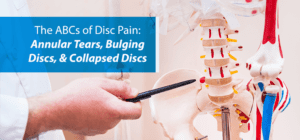
The ABCs of Disc Pain: Annular Tears, Bulging Discs, & Collapsed Discs
The spinal column has several components working together to ensure that your neck and back function properly. It serves a vital role in your body’s protection and functioning. A healthy spinal column allows you to stretch, bend, lean, and rotate. It also helps you maintain your balance and posture while protecting the spinal cord. Problems with the spinal column can lead to pain, muscle weakness, and decreased range of motion. This is especially true for the discs in between each vertebra. Injury, degenerative disc disease, and everyday wear and tear cause damage to the discs. In some cases, the pain can be a nuisance. Other times it severely limits your day-to-day functioning. Disc pain is usually associated with the lower back or neck area. These areas of the spine have the most mobility. The increased movement, along with the challenging task of supporting the body, often wears away at the intervertebral discs. Let’s take a look at the intervertebral discs and the common problems with them that can lead to pain. What is an Intervertebral Disc? In between each vertebrate is a round ligament, known as a disc, that keeps these bones connected. Discs provide the spine with shock absorption during the body’s everyday movements. In addition, discs give the spine added stability and allow for movement. Each disc is made of two main parts: Annulus Fibrosus: The outer layer of the disc is composed of strong ligament fibers. It connects the vertebrae and distributes pressure evenly throughout the disc. It also protects the inner layer from leaking out of the disc. Nucleus Pulposus: The inner layer of the disc is a jelly-like structure composed of water and collagen fibers. This flexible area provides shock absorption and protects the spinal cord and nerve roots. Lower back and neck pain can be caused by damage to either layer of the disc. The ABCs of Disc Pain Disc pain occurs for a variety of reasons. Here are common conditions: A: Annular Tears Ligaments are flexible, fibrous tissues that connect our bones and hold together the joints. Like your elbow, knee, and ankle, your discs are prone to injury. When the outer layer of the disc tears or ruptures, this is known as an annular tear. In many cases, annular tears are due to the body’s natural aging process. As we grow older, our discs start to break down, losing their strength and flexibility. This is known as degenerative disc disease. In fact, even in our thirties, our discs start to show signs of wear and tear. The slow breakdown of our discs puts them at risk for annular tears. Repetitive movements, high impact activities, or sitting for long periods make the discs more prone to annular tears. Car accidents and sports injuries are also a common cause for this type of injury. Most tears start from inside the annulus fibrosus and extend outward. Minor annular tears often don’t have any symptoms. If the damage is more severe, you may experience pain in
